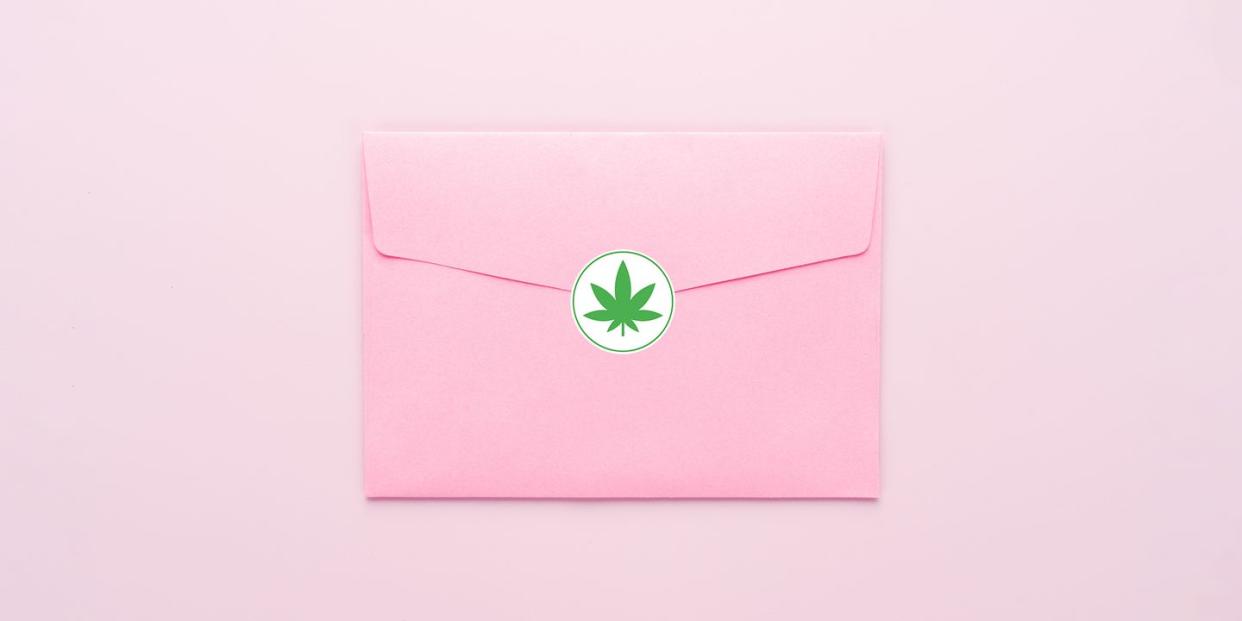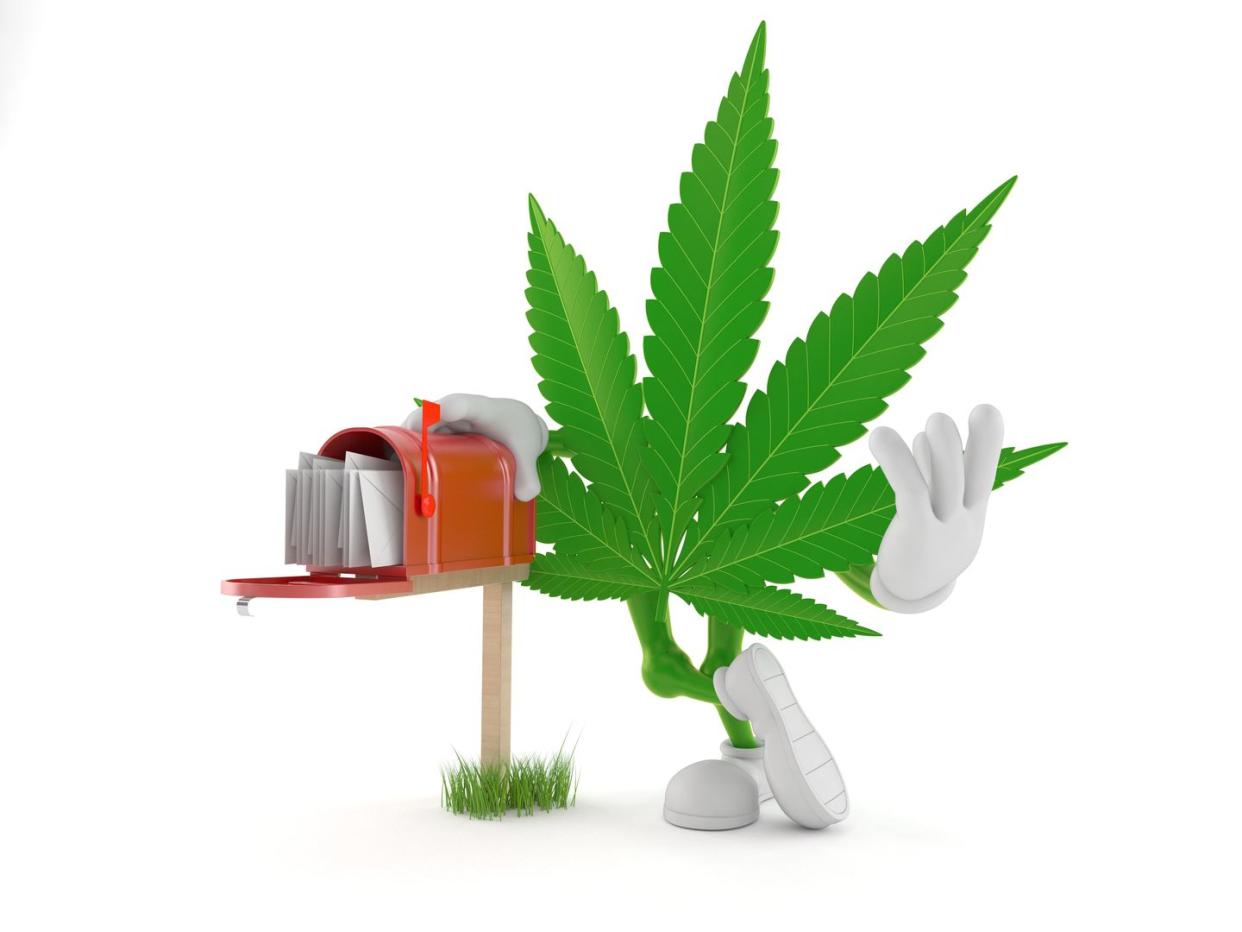How Risky Is It to Send Weed Through the Mail?

"Hearst Magazines and Yahoo may earn commission or revenue on some items through these links."
Esquire’s wise (and well-dressed) lawyers would like a word with you: They want to make it crazy-clear that the information in the story below is for entertainment purposes only and is not meant to aid or abet readers in the mailing of cannabis which, as we all know, is a federal crime punishable by up to five years in prison and $250,000 in fines. Even for small amounts.
If, like me, you live in one of the country’s 22 majestic recreational states, you may have received a call from a friend eking out a joyless existence in one of our sad, dry states. I have. And it sounded like this: Could you, like, maybe, just drop me a little you-know-what in the mail? Not even a quarter. Just a little something-something? I wanted to do my pal a solid, of course, but not enough to trade my carefully calibrated work-life balance for a prison phone and plexiglass. I wondered: At a time when church-going moms utter the word “budtender” with a straight face, when cannabis is advertised on towering roadside billboards (“Lake & Bake. Exit Now & Turn Left”), just how dicey is it to send a little weed to a friend in need?
I decided to find out.
I began assessing the odds by looking at the numbers. The USPS employs about 1,200 postal inspectors to hunt for suspicious packages, which might sound like a small army until you consider that the postal service processes 23.8 million packages a day (Fed-Ex does 16.5 million). And so while postal-service investigations led to 2,110 drug-related arrests last year, you can easily imagine that plenty of mild-mannered weed-bearing boxes skeetered through unnoticed.
In fact, when I spoke with cannabis growers—folks who literally bank on their shipments arriving unnoticed—they told me that they only send their weed via the US Postal Service. Why? Because if someone at FedEx or UPS senses something even slightly suspicious, they can immediately tear into a package; the US Postal Service, on the other hand, requires a federal warrant based on probable cause, which is a proper pain in the ass. (Oddly, the USPS vs. FedEx distinction isn’t common knowledge in the weed world: A leading PR rep who specializes in big cannabis brands was shocked to hear this and confessed that she’s been sending her “product samples” via UPS “because it’s closer to my house.”)
When I asked Michael Martel, a veteran postal inspector, what makes a package seem suspicious, he was (understandably) cagey: “In order to preserve the effectiveness of our investigative techniques, I can't really talk about what goes into identifying a parcel that makes it suspicious,” he told me. But Martel gamely confirmed a few red flags that others in the cannabis trade had mentioned to me: packages without a return address, those that are sealed with too much tape or carry excessive postage or exude an odor. Other grower-supplied gotchas: using a fake return address, a nonexistent return zip code, and a name not associated with the recipient’s address. Red flags and gotchas aside, it’s worth noting that the Postal Service does not need a warrant to X-ray a package and, in fact, Martel told me, some mail, especially mail traveling through larger cities, is routinely X-rayed. (Writing “Do Not X-ray” on a package, the USPS says, instantly marks it as suspicious.)

Secrets of a Former Dealer
Back when Luc Carlin was a teenager—years before he started his successful cannabis-education YouTube channel and consulting business—he may (or may not) have dealt a shit-ton of weed and may (or may not) have used the mail to service his clients. Successful cannabis-by-mail types, Carlin explained to me, take their step-by-step process seriously. First, he says, they slide the flower into a Ziploc bag and then lightly swab the bag with an alcohol wipe to reduce residue and odor. (Spraying with perfume or deodorizer ends up drawing more attention to the package and doesn’t actually eliminate the weed smell.) Then they vacuum-seal the Ziploc bag at least once but often twice. (“The vacuum sealer,” Carlin says, “is the core of it all.”) Next up, the zipped, vacced package is placed in a black, smell-proof Mylar bag. Carlin emphasizes the importance of not packing the box while sitting in a room in which weed has been smoked because the post office, he says, tests for residue. (He’s heard that the USPS uses a thin needle to pierce boxes and identify trace amounts of residue inside, to which Martel responded: “Myth. This is a good one.”) Using disposable gloves eliminates the transfer of any residue that happens to be on the packer’s hands.
The box itself is key. The pros use only new, clean boxes and reach for the smallest in which the bundle can comfortably fit, adding insulation so that the contents don’t shuffle around. The post office’s Priority Mail boxes often get the nod because they aren’t conspicuous and postage is standardized, so there’s less room for error. With respect to the outside of the box, Carlin says regular weed shippers keep it simple: “They go crazy with the security on the inside of the package, but they want the outside low-key so it blends in.” At the post office, cannabis senders pay only with cash. And with respect to sending edibles—the pre-packaged kind, not the burnt, homemade-cookie kind—Carlin believes “there’s very little to worry about,” especially if the gummies or chocolate gets packed inside a Mylar bag. On the receiving end of a package? Carlin preaches the gospel of “plausible deniability” and says that canny recipients wait 48 hours before opening a parcel; if the postal service or police come a-knockin’, you simply hand them the unopened box and say, “I don’t know anything about it.”
A Word from Law Enforcement
Given the millions of packages streaming through the postal service, I asked Inspector Martel how the relatively few postal inspectors prioritize their prodding, poking, and sniffing. Martel told me that, “Man-hours and investigative priorities are focused on the dangerous substances killing Americans.” Such as? “Everything from toxins like anthrax and ricin to fentanyl, meth, and opiates.” (He also mentioned explosives, scorpions, and snakes, but that’s another story). Martel knows of what he speaks: Before he became an information officer for the postal service, he spent eight years as a boots-on-the-ground inspector and once opened a package containing a full kilo of cartel cocaine.
Of course, a couple of joints—even “fatties”—can’t compare to a care package from the boys in Sinaloa. Martel wouldn’t say that the postal service shrugs off small-weight cannabis packages, but he did say, “If it's not something that would be prosecuted by the US Attorney's Office, I think we would lean more toward seizure and destruction than a criminal investigation.” It’s worth noting that the postal service is, like everyone else, improving its computer-assisted predictive modeling practices: “By combining individual package data with historical seizure data,” reads their strategy doc from 2020, “we can develop models that proactively target suspicious packages.”
And so, until the federal government legalizes cannabis on a national level, the cat-and-mouse game between weed senders and postal inspectors will continue, with inspectors turning to advanced tools and tech, and the cannabis crowd cooking up new tricks to blend in and slip through the cracks. So where does all this net out? Will mailing fifty bucks worth of dispensary-bought, smartly packaged cannabis end up with you Googling “bail bondsman near me”? My guess: likely not. Am I going to risk it? Also likely not.
You Might Also Like
